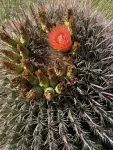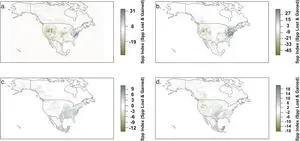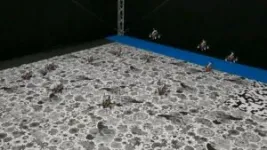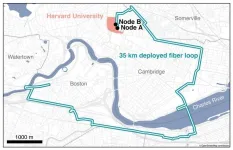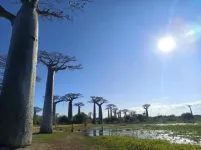(Press-News.org) Bee and butterfly populations are in decline in major regions of North America due to ongoing environmental change, and significant gaps in pollinator research limit our ability to protect these species, according to a study published May 15, 2024 in the open-access journal PLOS ONE by Sara Souther of Northern Arizona University, US, and colleagues.
Recent research has detected declines in populations of pollinator species, sparking alarm from scientists and policymakers concerned about negative impacts on ecosystems and agriculture. These declines have been linked to various factors including climate change, habitat loss, and invasive species, but reports are often limited to well-studied species in easily accessible regions. In this study, Souther and colleagues used data compiled on four major families of bees and butterflies to construct species distribution models, enabling them to assess changes over time and space across North America.
The highest species richness was found along North America’s West Coast, especially California and the Rocky Mountains. However, the models revealed declining species richness in all four families over the past century in western North America. In contrast, there were disproportionate increases in eastern North America. The authors also assessed similar data for a broader sample of potential pollinator species, including both invertebrate and vertebrate species of conservation concern, and found similar trends.
Comparisons with climate data indicate that these population changes are at least partly related to the impacts of recent climate change – such as prolonged drought and habitat degradation – and regions experiencing apparent population declines have also been heavily impacted by anthropogenic land use. The authors note too that the apparent increases in the eastern U.S. may partly reflect increased detections in these populous areas, given an increase in citizen science and similar data collection efforts.
Overall, this study detects broad trends of population changes in bees and butterflies, as well as other potential pollinators. These results help to identify regions of declining populations where researchers and policymakers can prioritize conservation efforts. This study also identifies gaps in existing knowledge of pollinators, including regions that are more poorly sampled and species that are less well studied, limitations that might be overcome by improved monitoring methods and enhanced citizen science efforts.
The authors add: “Existing records of North American pollinators suggest that diversity has broadly declined in the western US and southern Mexico in recent decades. Losses are consistent with changes in climate and suggest a need for increased monitoring to inform conservation and mitigation actions.”
#####
In your coverage please use this URL to provide access to the freely available article in PLOS ONE: https://journals.plos.org/plosone/article?id=10.1371/journal.pone.0289742
Citation: Souther SK, Sandor ME, Sample M, Gabrielson S, Aslan CE (2024) Bee and butterfly records indicate diversity losses in western and southern North America, but extensive knowledge gaps remain. PLoS ONE 19(5): e0289742. https://doi.org/10.1371/journal.pone.0289742
Author Countries: USA
Funding: This study was funded by a grant to C.A. by the Commission for Environmental Cooperation (http://www.cec.org/). The funders had no role in study design, data collection and analysis, decision to publish, or preparation of the manuscript.
END
Bees and butterflies on the decline in western and southern North America
Pollinator data indicates regions of concern and gaps in current knowledge
2024-05-15
ELSE PRESS RELEASES FROM THIS DATE:
Singing researchers investigate cross-cultural patterns in music, language
2024-05-15
Seventy-five researchers from 46 countries recorded themselves performing traditional music and speaking in their own languages in a novel experiment investigating cross-cultural differences and similarities.
With rare exceptions, the rhythms of songs and instrumental melodies were slower than for speech, while the pitches were higher and more stable, according to the study published in Science Advances.
Unique for the number of languages represented – 55 – and the diversity of the researchers, the study provides “strong evidence for cross-cultural regularities,” according to senior author Dr Patrick ...
Animal brain inspired AI game changer for autonomous robots
2024-05-15
A team of researchers at Delft University of Technology has developed a drone that flies autonomously using neuromorphic image processing and control based on the workings of animal brains. Animal brains use less data and energy compared to current deep neural networks running on GPUs (graphic chips). Neuromorphic processors are therefore very suitable for small drones because they don’t need heavy and large hardware and batteries. The results are extraordinary: during flight the drone’s deep neural network processes data up to 64 times faster and consumes three times less energy than when running on a GPU. Further developments of this technology may ...
Summers warm up faster than winters, fossil shells from Antwerp show
2024-05-15
Niels de Winter, affiliated with the Department of Earth Sciences at Vrije Universiteit Amsterdam and the AMGC research group at Vrije Universiteit Brussel, measured alongside colleagues from institutions such as the Institute for Natural Sciences in Brussels the chemical composition of fossil shells from Antwerp, Belgium. Those shells originate from molluscs such as oysters, cockles, and scallops found during the construction works of the Kieldrecht Lock. The molluscs lived lived during the Pliocene, approximately ...
Wearing face masks did not reduce risk of COVID infection after first Omicron wave, research shows
2024-05-15
After the first Omicron wave, research shows that many of the risks of Covid infection changed
Before February 2022, always wearing face masks and being retired were associated with reduced risk, but not after
Overseas travel was not associated with increased risk prior to February 2022, but then became a significant risk
Peer reviewed – meta-regression- humans
New research from the University of East Anglia has found that wearing face masks did not lower the risk of Covid infection following the initial surge of the Omicron variant.
The analysis of official data found that several risk ...
SF State receives $14M from the Genentech Foundation to support underrepresented students in STEM
2024-05-15
SAN FRANCISCO – May 15, 2024 – San Francisco State University announced today that it received $14 million from the Genentech Foundation to support two University programs that are training the next generation of life sciences leaders. The new five-year grant is the latest in the Genentech Foundation’s transformational support for University programs, which has totaled more than $33 million during their long-lasting partnership. This partnership has impacted more than 700 students since 2008, and an additional 350 students are projected to be supported by the new funding.
The new funds will continue sponsoring San Francisco State’s Genentech ...
Penalties for dropping out of ecosystem services incentive programs should equal lost environmental benefits
2024-05-15
Payment for Ecosystem Services programs (PES) are important tools that governments around the world use to improve water quality, protect forests and wildlife habitat, and sequester carbon. Under these programs, landowners - usually farmers - are paid to use their land in ways that protect or restore the environment, such as replacing row crops with trees or grassy zones adjacent to waterways. Many PES program contracts last 5 to 20 years, but participant drop out rates have consistently risen over the years.
A recent study by University of Maryland economists showed that PES programs ...
Lithuanian researchers’ new development in solar cell technology – a promise of a significant advancement in the field
2024-05-15
Researchers from Kaunas University of Technology (KTU), Lithuania, who contributed to the development of record-breaking solar cells a few years ago, expanded their invention. The self-assembled monolayers can now be applied not only in inverted but also in regular structure perovskite solar cells.
Self-assembling molecules arrange themselves into a single-molecule-thick layer and in this case, they act as an electron-transporting layer in solar cells.
“The molecules that make up these monolayers, like a clever glue, ...
A simple internet with significant possibilities
2024-05-15
It’s one thing to dream up a quantum internet that could send hacker-proof information around the world via photons superimposed in different quantum states. It’s quite another to physically show it’s possible.
That’s exactly what Harvard physicists have done, using existing Boston-area telecommunication fiber, in a demonstration of the world’s longest fiber distance between two quantum memory nodes to date. Think of it as a simple, closed internet between point A and B, carrying a signal encoded not by classical ...
Unwrapping the origin story of the baobab
2024-05-15
The baobab (Adansonia) is a genus of trees with eight extant (in existence currently) species and a long history of humans marveling at them. For as much admiration the baobabs get, there is an equal amount of mystery surrounding their origin.
Genomic and ecological analyses recently done by a global research team led by Sino-Africa Joint Research Center, CAS (hosted by Wuhan Botanical Garden of the Chinese Academy of Sciences), suggest that Madagascar, is the origin from where all other baobab species hail. With a deeper understanding of the baobabs' genetics, researchers are hoping to uncover some clues on what ...
The origin and long-distance travels of upside down trees
2024-05-15
The iconic baobabs, also known as upside-down trees, or the tree of life, have much cultural significance, inspiring innumerable arts, folklore, and traditions. A research published in Nature, involving international collaboration between Wuhan Botanical Garden (China), Royal Botanic Gardens (Kew, UK), University of Antananarivo (Madagascar) and Queen Mary University of London (UK) reveal a remarkable example of species radiation in Madagascar followed by long distance dispersal to Africa and Australia. With speciation, an astonishing divergence of pollination mechanisms evolved, that exploit hawkmoths, bats and lemurs for ...
LAST 30 PRESS RELEASES:
University of Oklahoma researcher awarded funding to pursue AI-powered material design
Exploring how the visual system recovers following injury
Support for parents with infants at pediatric check-ups leads to better reading and math skills in elementary school
Kids’ behavioral health is a growing share of family health costs
Day & night: Cancer disrupts the brain’s natural rhythm
COVID-19 vaccination significantly reduces risk to pregnant women and baby
The role of vaccination in maternal and perinatal outcomes associated with COVID-19 in pregnancy
Mayo Clinic smartwatch system helps parents shorten and defuse children's severe tantrums early
Behavioral health spending spikes to 40% of all children’s health expenditures, nearly doubling in a decade
Digital cognitive behavioral treatment for generalized anxiety disorder
Expenditures for pediatric behavioral health care over time and estimated family financial burden
Air conditioning in nursing homes and mortality during extreme heat
The Alps to lose a record number of glaciers in the next decade
What makes a good proton conductor?
New science reporting guide published for journalists in Bulgaria
New international study reveals major survival gaps among children with cancer
New science reporting guide published for journalists in Turkey
Scientists develop a smarter mRNA therapy that knows which cells to target
Neuroanatomy-informed brain–machine hybrid intelligence for robust acoustic target detection
Eight SwRI hydrogen projects funded by ENERGYWERX
The Lundquist Institute and its start-up company Vitalex Biosciences Announces Strategic Advancement of Second-Generation fungal Vaccine VXV-01 through Phase 1 Trials under $40 Million Competitive Con
Fine particles in pollution are associated with early signs of autoimmune disease
Review article | Towards a Global Ground-Based Earth Observatory (GGBEO): Leveraging existing systems and networks
Penn and UMich create world’s smallest programmable, autonomous robots
Cleveland researchers launch first major study to address ‘hidden performance killer’ in athletes
To connect across politics, try saying what you oppose
Modulating key interaction prevents virus from entering cells
Project explores barriers to NHS career progression facing international medical graduates
Jeonbuk National University researchers explore the impact of different seasonings on the flavor perception of Doenjang soup
Two Keck Medicine of USC Hospitals named Leapfrog Top Teaching Hospitals
[Press-News.org] Bees and butterflies on the decline in western and southern North AmericaPollinator data indicates regions of concern and gaps in current knowledge
